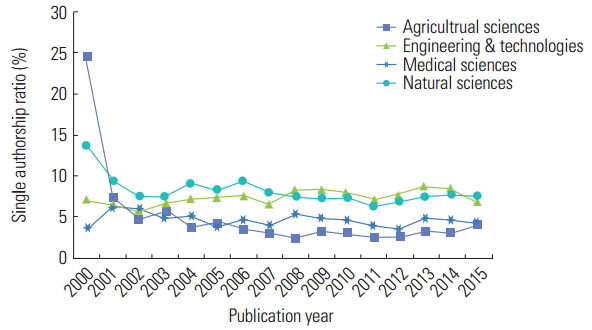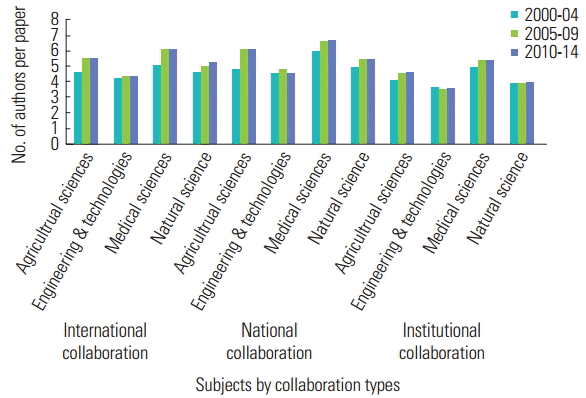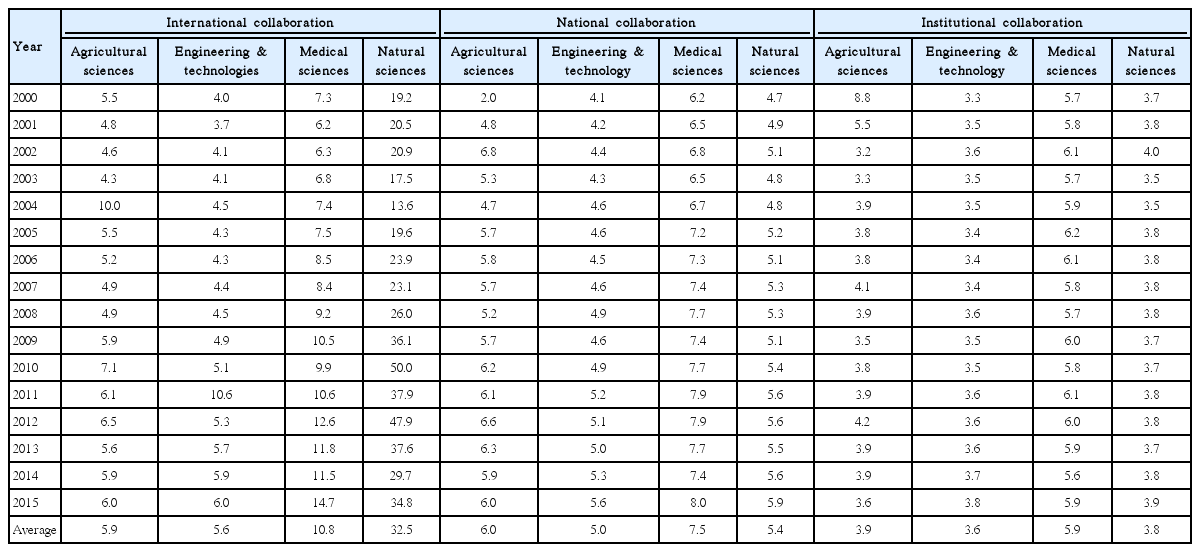Increasing number of authors per paper in Korean science and technology papers
Article information
Abstract
We examined changes in the number of authors per paper for science and technology papers (agricultural sciences, engineering and technologies, medical sciences, and natural sciences) in Korea. We employed the Scopus database to examine the change in the number of authors in papers, which were published from 2000 to 2015 in the 234 Korean academic journals indexed on Scopus. We found that the global trend of growth in the number of authors per paper is evident in Korea as well. While there was little evidence of a correlation with the citation per paper, a positive correlation was found between with the field-weighted citation impact, another measure of a paper’s impact, in medical and natural science papers. In terms of the type of collaboration, we found that international collaboration papers had the highest number of authors, followed by national and institutional collaborations. The number of authors per paper was highest for those published in the top 10% journals by Source Normalized Impact per Paper, followed by Scopus-indexed journals, while papers published in Korea Citation Index had the lowest number of authors per paper. We propose that the rise in the number of authors per paper in Korean papers may be ascribed to many Korean research programs encouraging group research and the widespread availability of the internet, which has stimulated joint research efforts and encouraged international collaboration.
Introduction
The number of papers in science and technology has increased every year, with growing coauthored papers from 42% of the world’s total science and technology articles in 1990 and 67% in 2010, with an annual growth rate of 4.4% in the number of authors per paper [1,2]. Korea has also seen a 20% increase in the number of science and technology papers over the past five years [3]. The definition, rights, and responsibilities of authorship have recently been the topic of active discussion in the international arena, and the growth in the average number of authors per paper is frequently noted [4]. Based on SCI archives, the average number of authors per science and technology paper in the US rose from 3.2 in 1990 to 5.6 in 2010 [1]. Meanwhile, an analysis of data from Scopus, which encompasses all academic fields, including the humanities, social sciences, and natural sciences - suggests that the average number of authors rose from 3.4 in 2003 to 4.15 in 2013. This rise was accompanied by a decrease in the proportion of papers by single authors, from 20% to 13% [5]. These widely-observed trends have been attributed to the growth of knowledge creation, joint international research and transfer and sharing of knowledge among research institutes and governments [4,6,7].
Is the worldwide phenomenon of an increase in the average number of authors per paper also occurring in Korea? If so, is it connected to unethical practices among researchers [8] or to the environment within which research is conducted? Such questions need to be addressed in order to determine whether this rise is part of a general phenomenon associated with the way in which academic research is currently conducted around the world. Recently, Huang et al. [9] reported that research collaboration, measured by the number of coauthors, the number of fields, and the number of countries, has increased significantly in the post-web stage compared with the pre-web stage. The empirical results suggest that the Internet facilitates communication among scholars.
In this study, we examine changes in the number of authors per paper for science and technology papers (natural sciences, engineering and technologies, medical sciences, and agricultural sciences) in Korea over the years from 2000 to 2015. We also examine whether the change in the number of authors is related to research impact of the papers (domestic, international, and papers in top 10% journals), the field of research, the number of citations, and the practice of joint research (projects jointly undertaken by domestic and international research institutes).
Methods
We employed the Scopus database to examine the change in the number of authors per paper. Two datasets were used for the analysis (Table 1): the first dataset comprised papers published from 2000 to 2015 in the 234 Korean academic journals published by Korean academic societies; the second dataset comprised papers by authors who are affiliated with Korean research institutes in the top 10% of journals in terms of the Source Normalized Impact per Paper (SNIP, measures contextual citation impact by weighting citations based on the total number of citations in a subject field) index provided by Scopus. The relevant papers were downloaded from Scopus. The number of authors for each paper was recorded, as well as the academic Subject area according to the Organization for Economic Cooperation and Development classification scheme covering the agricultural sciences, engineering and technologies, medical sciences, and natural sciences. In papers published in the 234 Korean journals, Koreans accounted for 77.4% of the authors (distribution of authors by nationality: South Korea 77.4%, China 10.4%, United States 6.6%, Japan 4.0%, India 4.0%, Iran 2.7%, Turkey 1.8%, Taiwan 1.3%, Australia 1.2%, and United Kingdom 1.1%). Thus, the majority of papers in the Scopus indexed Korean journals were authored by Koreans.
Results
Number of authors compared by subject area and form of collaboration
From 2000 to 2015, number of authors per paper in the 234 Korean journals on Scopus has grown gradually at an average rate of 0.9%. The average number of authors was highest in 2011, at 4.7, while the figure for 2015 was 4.4 (Fig. 1A). Based on the form of collaboration, joint research works may be classified as international, national, institutional, single authorship (non-joint research). Considering the number of coauthored papers by subject area (regardless of form of collaboration), papers in the medical sciences had the highest number of co-authors, averaging approximately 5.0 in the period of 2000 to 2015. The average number of authors was 4.7 in the case of agricultural sciences, 4.2 in the natural sciences, and 3.7 in engineering. Thus, the number of authors per paper in the medical sciences averaged more than 1.3 times that in engineering.
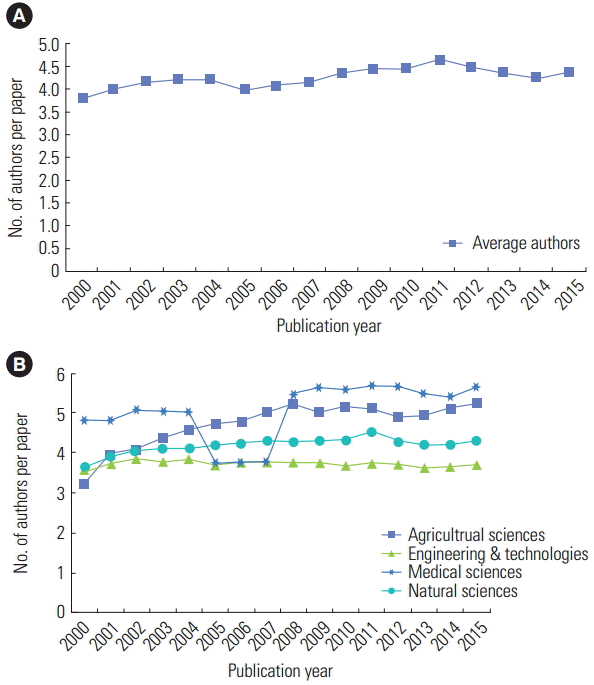
(A) Changes over time in the number of co-authors in Korean journals: 4 subject areas. (B) Number of co-authors by subjects and year.
The number of authors per paper in the medical sciences decreased to an average of approximately 3.7 from 2005 to 2007, before increasing sharply after 2008. Since 2003, the Korean Association of Medical Journal Editors has stressed research ethics in workshops and has continued to focus on these issues. This may be associated with the 2005 scandal over the paper by Hwang Woo-Suk, which became the subject of social scrutiny due to the inclusion of a co-author not fit for authorship. After the Lee Myung-Bak administration took office in 2008, the government vowed to commit 5% of the national budget to research and development efforts. This is considered to have led to a sharp rise in joint research, including research projects spanning multiple institutes. Meanwhile, in the field of engineering, the number of authors has remained more or less stable at 3.7 throughout the 15 years studied here (Fig. 1B).
Considering the number of co-authors in terms of the form of collaboration, national collaborations led to the most authors per paper, followed by international and institutional collaborations. This ordering was observed regardless of subject areas (Fig. 2). National collaboration papers in the medical sciences had the highest average number of co-authors (6.9), followed by international collaboration papers in the medical sciences (6.6 co-authors) and national collaboration papers in agricultural sciences (5.7 co-authors).

(A) Changes over time in the number of co-authors by subject area: international collaboration. (B) Changes over time in the number of co-authors by subject area: national collaboration. (C) Changes over time in the number of co-authors by subject area: institutional collaboration.
The number of papers published over the past 15 years has grown at an annual average rate of 12.3%. Considering only those papers with single authorship, the growth rate is 6%. Because the number of authors is fixed at one in the case of single authors, it is more meaningful to analyze the ratio of papers with single authors than the gross number of papers (Fig. 3) While this ratio was very high in the agricultural sciences in 2000 (at 24.7%), it fell to an average of 5.0% from 2000 to 2015. The ratio of single authorship is 7.3% in engineering, 4.7% in the medical sciences, and 8.1%, the highest, in the natural sciences. In terms of average growth rates, the single authorship ratio has grown at 0.9% in the medical sciences, while decreasing in other fields at rates of -11.2% in agricultural sciences, -0.2% in engineering, and -4.0% in natural sciences, respectively. These downward trends have also been observed internationally [6].
The field of natural sciences has the highest ratio (and the highest gross number of papers) of single authorship. Breaking this down in terms of fields of study reveals that the high ratio overall is due to a high ratio of single authorship in mathematics, namely 29.3%. This is due to the nature of academic research in mathematics, where there is less need for supporting personnel (such as graduate students) or joint research in comparison to other disciplines, as research is driven mainly by the ideas and mental capacities of individuals.
Analysis of the average number of authors per paper over the years from 2000 to 2015 in terms of three periods of five years yields Fig. 4 below. Over the three periods, the average number of authors grew most rapidly (13.3%) in national collaborations in agricultural sciences, followed by international collaborations in medical sciences (9.7%) and international collaborations in agricultural sciences (9.6%). The lowest growth rates were observed in engineering, including institutional collaborations (-0.5%), international collaborations (0.4%), and national collaborations (0.7%). The overall growth rate throughout the 12 types of collaboration over the three periods was 5.3%, with gradual positive growth observed for all types of collaboration except institutional collaborations in engineering and technologies, which fell by 0.5%.
Meanwhile, comparing the number of authors per paper for domestic papers registered on the Korea Citation Index (KCI) reveals no significant changes across the years 2000 to 2015, with somewhat fewer co-authors relative to foreign journals registered on Scopus (Fig. 5). The difference in the number of co-authors is about one author in the medical sciences, 0.72 in the natural sciences, and 0.56 in engineering and technologies.
The number of authors published in the top 10% journals by SNIP
Analysis of the number of authors of Korean papers published in the top 10% of SNIP journals indexed on Scopus during 2000 to 2015 led to the following findings.
The number of authors per paper in the top 10% journals by SNIP by types of collaboration
Comparing the ratio of Korean papers published in the top 10% journals of SNIP registered on Scopus from 2000 to 2015 reveals that, compared to the worldwide average and researchers from Japan or China, Korean researchers had a higher rate of publication in such journals (Fig. 6A).
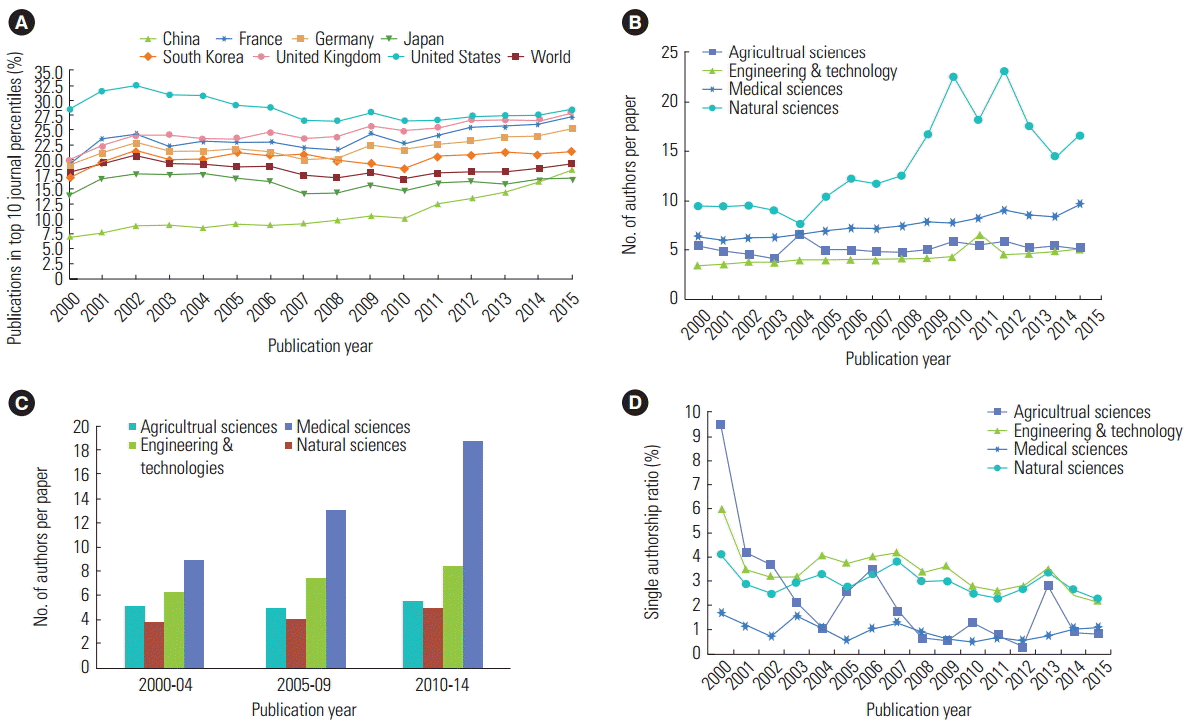
(A) Rate of publication in the top 10% journals by Source Normalized Impact per Paper (SNIP) (selected nationalities). Publication type of articles only included. (B) Average number of authors per paper in the top 10% journals by SNIP by subject area. (C) Number of authors by subject area (3 periods of 5 years). (D) Ratio of single authorship papers published in the top 10% journals by SNIP.
Considering the average number of authors per paper in the four subject areas over the years 2000 to 2015 reveals diverse characteristics across fields (Fig. 6B). In particular, papers in the natural sciences reflected the most changes and the highest average number of co-authors, for example, 23.1 in 2012 and 15.5 in 2015. This may be explained by the characteristics of research in physics, in which large-scale projects involving a large number of researchers such as the European Organization for Nuclear Research (CERN) project and other consortiums are common. There have been instances of author groups in physics with a maximum of 5,154 authors [10], and the existence of such large-scale projects may have contributed to the higher average number of authors in physics and the natural sciences in general. Data analysis reveals that the number of authors in agricultural science papers has remained stable, while engineering, medical sciences, and natural sciences have reflected average annual growth rates of 2%, 3%, and 4%, respectively.
Fig. 6C depicts the average number of co-authors per paper in the four fields of study over the three periods of five years. The number of co-authors has grown steadily in all fields except agricultural sciences, with the number rising from 3.8 in 2004 to 5.0 in 2014 in the case of engineering, from 6.3 in 2004 to 8.4 in 2014 in the medical sciences, and from 8.9 in 2004 to 18.8 in 2014 in the natural sciences. Among 4 subject areas, engineering and technologies papers had the lowest number (4.6) of co-authors.
Analyzing the average number of authors by types of collaboration (international, national, and institutional) reveals that the highest numbers of co-authors were found for international collaboration papers (Table 2). International collaborations in the natural sciences reflected the highest number of authors per paper (32.5), followed by international collaborations in the medical sciences (10.8), and national collaborations in the medical sciences (7.5). Meanwhile, institutional collaborations yielded papers with the smallest numbers of co-authors, particularly in the fields of engineering and technologies (3.6), natural sciences (3.8), and agricultural sciences (3.9).
Single authored papers published in the top 10% journals by SNIP
The proportions of single-author papers are summarized in Fig. 6D, showing an average of 2.3% in agricultural sciences, 3.5% in engineering and technologies, 1.0% in medical sciences, and 3.0% in natural sciences. In the case of the top 10% journals by SNIP, the share of single-author papers was revealed to be low as compared to 234 Korean academic journals. While the subject area with the most single-author papers in these journals was engineering and technologies (3.5%), limiting the analysis to the 234 Korean journals reveals that the most single-author papers were in the natural sciences (8.1%). The average difference in these proportions of single-author papers in Korean and SNIP journals by subjects was found to be 3.8%. This may be explained by the fact that far more co-authored than single-author papers are submitted to top journals. The increase in the number of co-authored papers has been observed globally as well [11].
The relationship between papers’ impact and number of authors
The relationship between the number of authors and citations per publication
Might the number of authors of a paper be related to its impact, in terms of how often it is cited? If these two factors are observed to be correlated, then the recruitment of co-authors may affect a paper’s potential impact. The graphs in Fig. 7 plot the number of authors per paper against the citations per publication (CPP). As is clear from these figures, there appears to be no significant correlation between the number of authors and the CPP. The downward annual trend in the CPP is probably due to the fact that newly written papers tend to cite older papers, resulting in higher citations for older papers and fewer citations for newer papers.
The relationship between the number of authors and the field weighted citation impact
Comparison of the correlations between the number of authors and the field weighted citation impact (FWCI; divides the number of citations received by a publication by the average number of citations received by publications in the same field, of the same type, and published in the same year) in the four subject areas shows that the FWCI tends to be higher for papers with more authors in the fields of medical and natural sciences (Fig. 8). However, this effect was not substantial in the fields of agricultural science and engineering and technologies. While various factors other than the number of authors must be considered, further enquiry into this issue remains for future research, as the present paper focuses on the effects of the number of authors.
Discussion
The number of papers published in the 234 Korean journals indexed on Scopus increased at an average annual rate of 12.3% from 2000 to 2015, while the number of papers written by authors who are affiliated with universities in Korea and published in international journals grew by 20.7% from 2010 to 2015 [3]. Meanwhile, the average number of authors per paper grew steadily at an average rate of 0.9% from 2000 to 2015. While the proportion of single authorship papers grew by 0.9% in the case of medical sciences, in the fields of agricultural sciences, engineering and technologies, and natural sciences reflected negative growth rates of -11.2%, -0.2%, and -4.0%, respectively. In terms of the number of authors per paper and the FWCI in the four subject areas, a positive correlation was revealed for medical and natural science papers. However, no substantial correlation was observed for agricultural sciences and engineering and technologies. The upward trend in the number of authors per paper is evident in Korean-authored papers and foreign journals. In the discussion below, we consider a range of factors in the Korean context to determine a possible explanation for these phenomena.
Subject areas and number of authors
Analysis of the average number of authors per paper reveals differences between subject areas (Fig. 1B, 2B). In particular, the natural sciences have seen the largest changes, as well as the highest average number of authors per paper. This may be explained by two factors. First, there is the changing research environment in Korea. Comparing papers published in top 10% journals by SNIP in terms of nationality, Korean researchers had a higher share relative to the worldwide average, as well as to the shares of Japanese and Chinese researchers (Fig. 6A). Research subsidies by the Korean government are a major factor behind this finding. The Korean government has placed emphasis on the natural sciences and pursues subsidy programs such as Brain Korea 21 (1999-2007, 2008-2012) and the World Class University (2008-2012), directed at high-performing universities, leading to larger research teams and more participants in writing research papers. As a result, the Korea’s ranking in terms of the total number of papers indexed by Scopus reflected an upward trend from 19th place in 1996, 16th in 1999, 14th in 2001 to 13th place in 2004. Since 2006 year, Korea has maintained 12th place based on scholarly output.
Another factor is the influence of international collaboration. Large-scale projects like CERN and other consortiumled projects fall into this category, and involve a large number of researchers. Worldwide trends toward ‘big science’ and the emergence of large-scale research projects have encouraged the growth of joint research projects through international collaboration. There are as many as 171 papers in the natural sciences (such as physics papers published in Physical Review Letters, Physics Letters, the Journal of Instrumentation, etc.) with more than 2,000 co-authors, while more than 12,000 researchers from 70 nations are a part of the CERN’s Large Hadron Collider consortium [12]. These factors naturally influence the growing number of authors in these fields. It has been reported that co-authorship encourages the chance of citation, and that international collaborations tend to have better indicators of impact that generic co-authored papers [13].
National vs. international papers and number of authors
The number of authors per paper was shown above to be the highest in papers published in the top 10% journals by SNIP, followed by those indexed on Scopus, and lowest in papers in the KCI (Figs. 1, 3, 5, 9). This may be due to the fact that multiple researchers are brought in to collaborate to ensure research quality before submitting to top journals. On the other hand, researchers may find that submission to and publication in KCI-indexed journals are less competitive than in the case of top journals or Scopus-indexed journals, thus leading to a lower numbers of co-authors. While various interpretations are possible, different researchers do tend to target different journals (e.g., those registered on the Web of Science, Scopus, and the KCI) and may therefore participate in collaborative teams of various sizes.
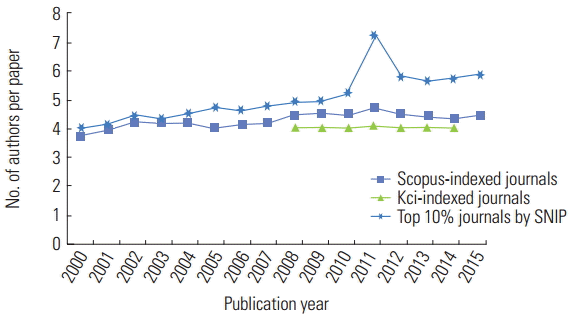
Comparison of number of authors per paper (Scopus-indexed journals, Korea Citation Index-indexed journals, and top 10% journals by Source Normalized Impact per Paper).
On a more practical note, many researchers at Korean institutions tend to favor publication in foreign journals, which increases their chances of promotion and other awards. Furthermore, participant researchers tend to be concerned about the number of papers they are able to publish. In particular, younger researchers tend to be more concerned with promotions, tenure, contract extensions, and awards. There tends to be fierce competition for research funding provided by government-funded research institutions, and such research funding depends upon researchers having adequate credentials. Performance assessments within research institutions place priority and greater weighting on papers published internationally (in Web of Science or Scopus-indexed journals), and leading journals like Nature express no concern about papers having many authors. The recently released “Study on academic research and development activity in Korea,” reports that, during the past five years, papers in the fields of natural science, engineering and technologies, medical science, and agricultural science published in SCI journals outnumbered those published in domestic (KCI) journals by two to three times [3].
Regarding the hypothesis that there is a quality difference between papers published in domestic journals and those published in foreign journals, we analyzed the number of authors per paper of papers published in domestic (KCI) and the top 10% journals by SNIP. Is the number of authors of frequently-cited (i.e., high-impact) papers increasing? As mentioned above, the correlation between a paper’s number of authors and its impact may be of interest; if a positive correlation exists, bringing in multiple authors may potentially result in a higher-impact paper. However, the correlation between the number of authors and the CPP, one measure of impact, was found to be insubstantial (Fig. 7). Furthermore, comparisons of the number of authors per paper and the FWCI, another measure of impact revealed a positive correlation in the case of medical and natural science papers, but none for agricultural sciences and engineering and technologies (Fig. 8).
Meanwhile, in terms of types of collaboration, papers prepared through international collaboration were found to have the highest number of authors (Table 2). These results would be related to two types of environmental factors for internally and externally: (1) the internal environmental factor is that the Korean governmental research direction is to emphasize collaborative research, group research programs such as the advanced research center programs, Global Research Lab and others during the last 10 years [3]. (2) the external environmental factor, the availability of the internet has greatly stimulated joint research efforts, encouraging collaborative research and international collaborations as reported by others [7,9,14]. It has been also reported that improved communications (the Web, Skype, cheaper travel) is one of factors for the huge increase in international scientific collaboration [13].
Number of authors and ethical considerations
Along with the rising number of authors of single research papers, the number of guest and ghost authors has also risen [15]. This phenomenon is part of a global trend, and the growth in the number of guest authors and honorary/gift authors has led to calls for greater transparency and account-ability regarding the contributorship of coauthors [16]. This study lacked objective data regarding growth in the number of authors and accompanying ethical considerations. However, as discussed above, the Korean preference for international publications and growth in the number of authors may have partially been influenced by the practice of inviting guest or gift authors.
Realistically, even in the event that a particular contributor to a paper considers an author’ contribution to be too minor to report, a journal editor may find it difficult to restrict a first author who lists 10 researchers, insisting that all are eligible as coauthors, unless an explicit upper cap is set in the submission regulations. Korean journals have not yet adopted an accountable contributorship system. While all research institutions state the four requirements for authorship in their research ethics guidelines, these are not particularly realistic [17]. While regulations strictly restrict the roles of authors, the internal workings and roles of each author are not externally observable, making it possible to include as many coauthors as one wishes. In the case of papers in the medical sciences, while an author might be held accountable for the findings of a paper, an author is not held accountable to the same degree when the findings are applied to patient care with adverse outcomes. This is because not all medical research papers are immediately connected to patient treatment. Thus, it is rare for an author’s accountability to lead to a socially problematic issue.
In conclusion, we found that the global trend of growth in the number of authors per paper is evident in Korea as well. While there was little evidence of a correlation with the CPP, one measure of a paper’s impact, a positive correlation was found between with the FWCI, another measure of a paper’s impact, in medical and natural science papers. In terms of the form of collaboration, we found that international collaboration papers had the highest number of authors, followed by domestic and within-institute collaborations. The number of authors per paper was highest for those published in the top 10% journals by SNIP, followed by Scopus-indexed journals, while papers published in KCI-indexed journals had the lowest number of authors per paper. We propose that the rise in the number of authors per paper in Korean papers may be ascribed to many Korean research programs encouraging group research and the widespread availability of the internet, which has stimulated joint research efforts and encouraged international collaboration.
Notes
No potential conflict of interest relevant to this article was reported.
Acknowledgements
We would like to express our gratitude to Dr. Kim So-Hyung of the National Research Foundation of Korea, who provided us with access to the KCI data.


